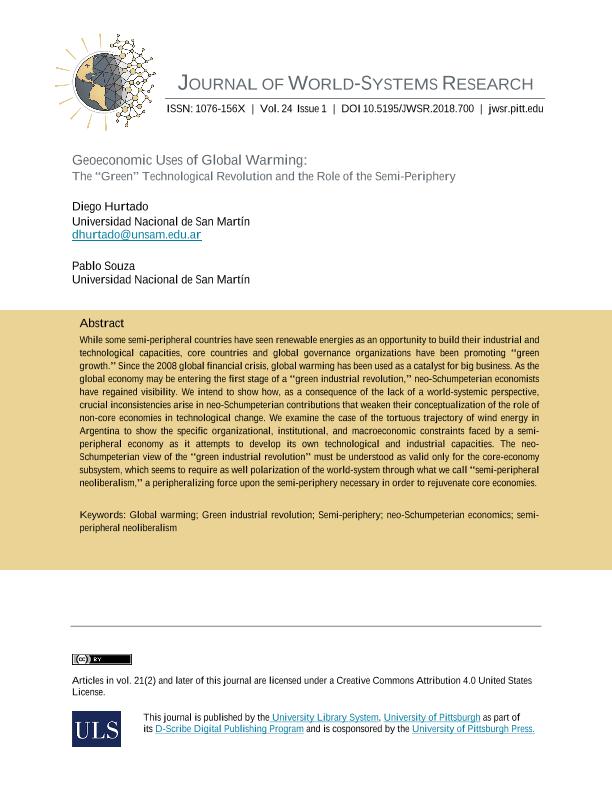Mostrar el registro sencillo del ítem
dc.contributor.author
Hurtado de Mendoza, Diego Fabian

dc.contributor.author
Souza, Pablo Andres

dc.date.available
2022-11-10T14:22:27Z
dc.date.issued
2018-06
dc.identifier.citation
Hurtado de Mendoza, Diego Fabian; Souza, Pablo Andres; Geoeconomic Uses of Global Warming: The “Green” Technological Revolution and the Role of the Semi-Periphery; University of Pittsburgh; Journal of World-Systems Research; 24; 1; 6-2018; 123-150
dc.identifier.issn
1076-156X
dc.identifier.uri
http://hdl.handle.net/11336/177283
dc.description.abstract
While some semi-peripheral countries have seen renewable energies as an opportunity to build their industrial and technological capacities, core countries and global governance organizations have been promoting “green growth.” Since the 2008 global financial crisis, global warming has been used as a catalyst for big business. As the global economy may be entering the first stage of a “green industrial revolution,” neo-Schumpeterian economists have regained visibility. We intend to show how, as a consequence of the lack of a world-systemic perspective, crucial inconsistencies arise in neo-Schumpeterian contributions that weaken their conceptualization of the role of non-core economies in technological change. We examine the case of the tortuous trajectory of wind energy in Argentina to show the specific organizational, institutional, and macroeconomic constraints faced by a semiperipheral economy as it attempts to develop its own technological and industrial capacities. The neoSchumpeterian view of the “green industrial revolution” must be understood as valid only for the core-economy subsystem, which seems to require as well polarization of the world-system through what we call “semi-peripheral neoliberalism,” a peripheralizing force upon the semi-periphery necessary in order to rejuvenate core economies.
dc.format
application/pdf
dc.language.iso
eng
dc.publisher
University of Pittsburgh
dc.rights
info:eu-repo/semantics/openAccess
dc.rights.uri
https://creativecommons.org/licenses/by/2.5/ar/
dc.subject
SEMI-PERIPHERY
dc.subject
GLOBAL WARMING
dc.subject
GREEN INDUSTRIAL REVOLUTION
dc.subject
NEO-SCHUMPETERIAN
dc.subject.classification
Otras Sociología

dc.subject.classification
Sociología

dc.subject.classification
CIENCIAS SOCIALES

dc.title
Geoeconomic Uses of Global Warming: The “Green” Technological Revolution and the Role of the Semi-Periphery
dc.type
info:eu-repo/semantics/article
dc.type
info:ar-repo/semantics/artículo
dc.type
info:eu-repo/semantics/publishedVersion
dc.date.updated
2022-11-07T10:08:01Z
dc.journal.volume
24
dc.journal.number
1
dc.journal.pagination
123-150
dc.journal.pais
Estados Unidos

dc.journal.ciudad
Pittsburg
dc.description.fil
Fil: Hurtado de Mendoza, Diego Fabian. Universidad Nacional de San Martín. Escuela de Humanidades. Centro de Estudios de Historia de la Ciencia y de la Técnica "José Babini"; Argentina. Consejo Nacional de Investigaciones Científicas y Técnicas; Argentina
dc.description.fil
Fil: Souza, Pablo Andres. Universidad Nacional de San Martín. Escuela de Humanidades. Centro de Estudios de Historia de la Ciencia y de la Técnica "José Babini"; Argentina. Consejo Nacional de Investigaciones Científicas y Técnicas; Argentina
dc.journal.title
Journal of World-Systems Research
dc.relation.alternativeid
info:eu-repo/semantics/altIdentifier/url/http://jwsr.pitt.edu/ojs/jwsr/article/view/700
Archivos asociados
